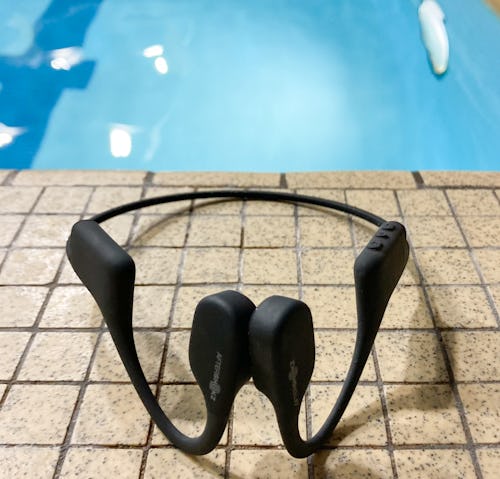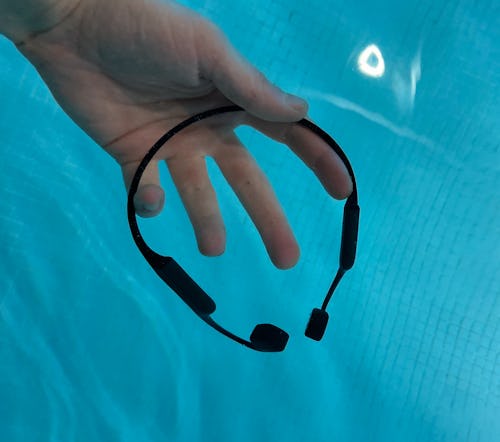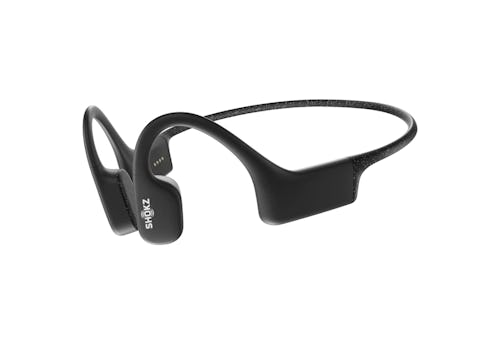
I’m training for an Ironman 70.3 later this year, so I’ve been swimming laps a few mornings each week. Ever since getting the Shokz OpenSwim waterproof headphones, it’s been remarkably easy to drag myself out of bed in the morning just to jump into the cold, unforgiving water.
It’s almost fun to spend an hour in the pool now that I can listen to an episode of Jamie Loftus’s Lolita Podcast or a Vampire Weekend album instead of being stuck with my thoughts.
Sound waves, pool waves, etc.
I am new to bone conduction headphones and I was absolutely shocked by how well I could hear the music in the pool. Bone conduction headphones are not new technology — they’ve been around for many years. They work quite simply: Sound waves vibrate the skull bone, allowing you to perceive audio without blocking the ear canal.
Perhaps this is just a personal problem, but I try to avoid thinking about how my brain perceives the world’s rich color and sounds by making sense of tiny little waves — it bends my mind. But when headphones send an audiobook straight into my skull, I’m forced to remember the mind-bending physics that underly the most basic aspects of existence.
Bone conduction, by the way, is one reason why people think their voice sounds different when hearing it played back — the skull conducts lower frequencies (deep tones) better than air does, so we hear our own voices as deep and full while others hear them as more high and tinny.
The Shokz OpenSwim sound good above the water but even better below the water.
There are separate settings for above and below water. Overall, the Shokz OpenSwim sound okay above the water but even better below the water, especially when you’re wearing earplugs (a pair comes included). You can’t count on catching the subtleties of your song, but you can certainly get the gist— and the bassline.
When I listen to podcast episodes, I never struggle to hear the words even as I splash around. I won’t be using these for dry-land tasks like cleaning the house and going to the grocery store, but I certainly could. There’s some noticeable sound leakage above water: When I was listening to a song on the couch, my friend could identify it from two feet away.
Fit is personal. The OpenSwim rested loosely over my ears, and even though they weren’t tight, they stayed on for every flip turn. I never worried they’d fall off, but even if I did, I knew I could tuck the back strap under my swim cap.

Load your audio beforehand
Bluetooth devices use 2.4GHz radio frequency, which doesn’t work well in water. But with 4GB of internal storage, I didn’t feel very limited. You can connect your headphones to your computer via USB-A using the charger cable. Some laptops, such as the current M1 MacBook Air and MacBook Pro only come with USB-C ports, so you’ll need an adapter. If you’ve still got an iTunes library full of MP3 files, then loading audio content is as easy as a drag and drop. Otherwise, it’s not too difficult to find ways to download podcasts, audiobooks, or music as files. The headphones support MP3, AAC, WMA, WAV, and FLAC.
Load them in the order you want to listen so you’re not skipping through your library. You can also use shuffle, which chooses tracks randomly from your 4GB library. Shokz advertises the battery life as eight hours, which is consistent with what I found — you’re good for a few different pool sessions before you have to charge. Shokz includes a proprietary charger with your purchase, and if you lose it, the replacement is $15.
I haven’t been able to shut up about how great these underwater headphones are.
The controls are pretty tiny and not totally intuitive, but you can figure out the basic commands from the attached guide. There’s multifunction/power button (A), mode button (B), and Volume + (C) and Volume - (D). To go to the next track, hold down on the Volume + button for two seconds. At first, I accidentally skipped tracks when I tried to turn up the volume because I held down on the button too long, but I figured it out pretty quickly.
I haven’t been able to shut up about how great these underwater headphones are. No need to attach to a goggle strap, no need to fiddle to find the Goldilocks position that allows the sound to blast into your ear canal, no need for your brain to turn to mush after miles of mindless laps.
That said, the Shokz OpenSwim certainly isn’t the only set of underwater headphones on the market. If you’re dead set on streaming from your phone, check out the Zygo Solo ($299); it only lasts for three hours of playtime, though. It also requires you to place its transmitter poolside which sends a radio frequency to your headset. More price-conscious shoppers can check out the Pyle Flextreme MP3 earbuds. They aren’t bone conduction, but they have an impressive 8GB flash storage and costs a third as much as the OpenSwim at $47.99.
Input may receive a portion of sales if you purchase a product through a link in this article. We only include products that have been independently selected by Input's editorial team.








